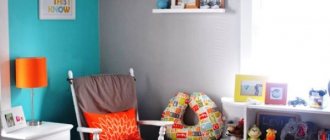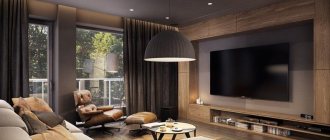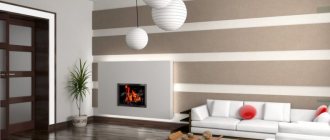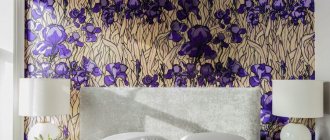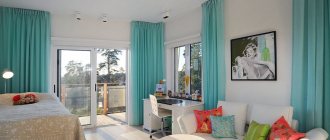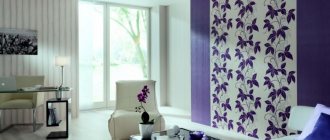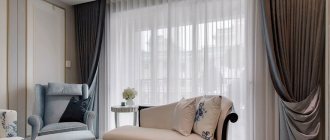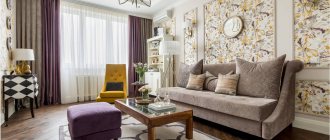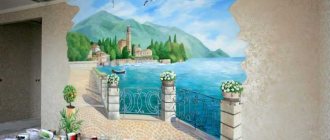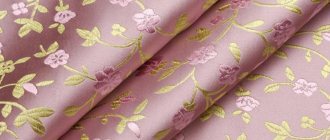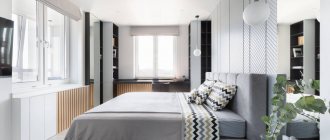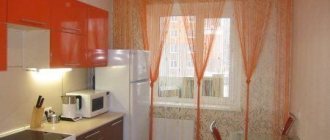Please note that different techniques can be implemented simultaneously to make the interior even more interesting.
Each method of combining two wallpapers involves creating stylish accents in a hall or living room, but if you find such methods too complicated, use the simplest one: glue the second type of wallpaper to the entire surface of the wall that will be the main wall in the room.
Combinations of shades and patterns
The design of the sticker depends on many factors. Firstly, both the brightness of the colors and the size of the patterns must be chosen based on the area of the room. In a cramped room, wallpaper should be as light as possible and include only small prints.
Secondly, the psychological aspect plays an important role in choosing combined wallpaper.
Each selected shade should emphasize a cozy atmosphere, so experts recommend giving preference to pastel colors. But the accents in the combinations can be made brighter and more expressive : this will emphasize the desired dynamics and solemnity of the interior.
The most common patterns used in wallpaper combinations are classic, floral and geometric patterns. All of them are perfectly combined with plain materials or wallpaper with thin stripes.
Patterned wallpapers are not recommended to be combined with each other, even if they have a pattern similar in style. If you decide on this option, the wallpaper should have a common palette.
Design of combined wallpaper for the living room, photo
A popular solution in modern interiors is combining patterned wallpaper with photo wallpaper and imitation materials . For example, floral motifs can be combined with landscapes or wallpaper stylized as wood. And brickwork harmonizes perfectly with abstraction - this is one of the signs of the loft style.
Wallpaper with accent patterns should not be glued close to each other . If this is a vertical combination, consider maintaining a decent distance between the bright inserts, where wallpaper with a calmer design will be pasted.
As for horizontal combinations, it is important to choose the right color and pattern. The lower part of the walls is most often made darker and monochromatic. In the classic style, striped wallpaper is allowed. The upper zone can be both light and bright (depending on the size of the room): it is often decorated with floral motifs or geometric patterns.
A few words about combining textured wallpaper
When deciding how to hang two types of wallpaper in the room, pay attention to their textures. If this is textured wallpaper intended for plain coloring, there will be no difficulties in combining it.
Textured wallpaper on a textile basis is a good option for a living room from a design point of view. But in practice, this material is quite capricious, and in combination with ordinary wallpaper it does not always look advantageous. Therefore, most often textile coverings are used to create inserts in the form of patterned panels on free walls: to decorate them you will need moldings or a finished frame.
Liquid wallpaper will look good in combination with most textured wallpapers. But vinyl and non-woven materials must be selected based on the relief pattern.
Modern interiors use embossed wallpaper with classic ornaments, floristry, abstraction, stripes and small touches. If a large section of the walls is decorated with this type of wallpaper, you should not select a relief pattern for the remaining surfaces.
Now you know how to beautifully hang two types of wallpaper in the living room: by choosing different shades and textures, this room can be made bright and festive or, conversely, calm and relaxing.
Choose suitable materials for combinations together with your loved ones and turn one of the ideas shown in the photo into reality.
Wallpaper features
In an apartment or house setting, wallpaper can cope with several tasks:
- Decorate the interior;
- Set the style and mood of the room;
- Hide small defects in the main wall decoration;
- Imitate any finishing material.
Among the disadvantages of this type of finishing, one can highlight the fact that wallpaper is susceptible to destruction from high humidity, exposure to direct sunlight, rapid contamination from dust and hand touch (not all samples).
What tools will you need for the job?
So, what does an apartment owner who has started a renovation need to prepare:
- Ladder. It is advisable to use a small and stable stepladder, since there will be massive work to be done on the walls and ceiling.
- Container for diluting wallpaper glue.
- Brushes or glue roller.
- Scissors, stationery knife, pencil, tape measure. The preparation of wallpaper strips for subsequent pasting of walls should be clear and measured. To achieve perfect edges and smooth joints on the walls, take the time to use a pencil and a sharp utility knife.
- Spatulas of various diameters for uniform application of glue to the wallpaper strip.
- A building level that will allow you to determine the error on the wall surface.
In addition, before starting repairs, make the necessary calculations of the area of the room. This will help you prepare the right amount of glue and wallpaper material.
Types of wallpaper
Wallpaper is classified according to the composition of the material from which it is made, as well as the width of the roll and variety of styles.
Paper
The most budget option. Made from environmentally friendly, breathable material. Inexpensive, but extremely impractical: they quickly become dirty and wear out. Subject to mechanical damage.
If you give preference to paper wallpaper when choosing, then you should pay attention to samples from several layers, rather than from one. The paper product is produced in matte and glossy versions.
Made from acrylic
Acrylic models are the same as paper ones, but with acrylic application. They differ from their older brothers in that they have a textured texture. More durable than regular paper ones. Otherwise they have the same performance characteristics.
Made from vinyl
Vinyl samples are denser and more practical. Resistant to moisture and dirt. They are painted. Consist of textiles and plastic. Not very environmentally friendly.
Non-woven
Non-woven wallpaper is easy to care for. They are washable and stick on without any problems. The difference in application to walls is that when gluing it is enough to apply the adhesive composition only to the wall. There is no need to apply it to the wallpaper. They can be washed.
Textile
One of the most expensive options, made of fabric. Gluing is extremely difficult. Only professionals can handle this.
- Otherwise, the expensive finishing material can be damaged already at the gluing stage, since gluing must be done very carefully, preventing the adhesive from getting on the front side of the canvas.
- They look chic and “rich” on the wall.
Metallized
This type of wallpaper is textile plus a metal coating (mainly aluminum). The heavy-duty fabric protects the room from electromagnetic radiation.
Bamboo
Rare exclusive beautiful wallpapers. Used to create a natural or ethnic style in the interior.
Cork
This type of wallpaper is made from cork veneer, which does not absorb odors. Cork fabric adheres well, retains heat and provides additional sound insulation to the room. Pleasant to the touch.
Glass wallpaper
Made from fiberglass threads. They are environmentally friendly. If desired, paint in any color you like (can be repainted). The wallpaper is very durable and long-lasting to maintain. They can be washed. The price of the material is quite high.
Photo wallpaper
If you want to add some zest to the interior or “revive” a boring environment, then this can be easily done with the help of photo wallpaper. Nowadays, photo wallpapers with a 3D pattern are in trend.
They are able to expand the space visually and create an incredible design in the room. Photo wallpapers open a “window” to a new world in any room.
Liquid
If you don’t have the knack for wallpapering or you’re tired of the classic version of paper and vinyl wallpaper and want something new in decoration, buy liquid wallpaper.
- The name of the material speaks for itself.
- Manufacturers offer both a ready-made solution for application and a dry solution that you need to dilute yourself with water.
- The main advantage of such wallpaper is that you don’t need to “adjust” it when gluing it, and there are no joints.
- Before pasting the room, the dry solution is diluted with water according to the instructions and applied to the walls like plaster.
Horizontal division with wallpaper
You can combine different wallpapers in a room using a horizontal principle. The wall is divided into two or several parts and is designed with straight lines that extend the space in breadth . Horizontal combinations of wallpaper are most often implemented in residential premises with the aim of visually expanding the area and lowering the ceiling level.
There are several ways to hang different types of wallpaper horizontally:
- textured horizontal stripes on the entire wall are framed with moldings or special strips and play the role of continuous decorative inserts;
- wallpapers of different types with similar themes and colors divide the wall into two parts and are separated with the help of auxiliary devices;
- textured wallpaper is glued only to the lower part of the wall, creating the effect of a protective panel for the walls.
Tip: horizontal division of walls can be easily transformed into a complex combination: the wallpaper border is cut in a wavy or zigzag shape. To ensure an easier process of creating such a composition, you can use liquid combined wallpaper.
In order for the interior to be perceived harmoniously, pay attention to the shade of the purchased materials for combination . As a rule, when dividing walls horizontally, dark wallpaper is used for gluing in the lower zone of the surface, while light coatings decorate the upper part, creating a bright and comfortable environment.
Dimensions and glue
Wallpaper comes in standard width (narrow) and wide. At the moment, wide canvases are popular. Gluing work with them goes faster than with standard rolls.
Wallpaper is also distinguished by the presence of large and small patterns, color palette, with or without adjustment, washable or moisture-resistant. By theme: for the living room, bedroom, kitchen, nursery and hallway.
- When purchasing glue, take into account the type of wallpaper, its severity (weight), and the number of rolls (always take a roll in reserve, just in case).
- Paper wallpapers can theoretically be “planted” with any glue, but vinyl and non-woven (or other) wallpapers cannot be glued to an adhesive solution intended for gluing paper samples.
This kind of glue is absolutely not suitable: the canvas will fall off the wall.
Removing old paint
You need to clean the walls of paint as thoroughly as possible. Old layers can peel off new wallpaper very quickly. Great difficulties arise when removing waterproof types of paint - before starting work you will need mechanical action with a stiff brush or knife.
If desired, you can use various chemical reagents to blur the paint layer, but this method is not entirely safe.
Classics of the genre in modern times
There are certain criteria when choosing wallpaper rolls for a specific room. Color and texture play a role here. operational characteristics.
Living room
For the main room of the house, calm tones and discreet colors are suitable. Canvas of beige, greyish, bluish, sand, light green color with a barely noticeable pattern or wallpaper with a textured texture, “embossed” pattern, as well as imitation plaster.
- The color and pattern of the wallpaper should not irritate or overwhelm. The entire environment should feel cozy and present lightness, even in a bulky, rough and “heavy” loft.
- By the way, there is wallpaper that imitates a red brick wall, photo wallpaper with graffiti and with thematic inscriptions and drawings. And, if you really want to try to bring the loft style to life in your living room, but don’t have the money for original finishing materials, then why not take advantage of a good idea and hang brick wallpaper?
- Your own home - freedom of creativity. Again, if the experience is unsuccessful, then changing the wallpaper will not be difficult. This is a big plus of this finish.
The rustic style (or Provence) still prefers light colors and flowers. Classicism never goes away from bas-reliefs, architectural ornaments and gilding, although neoclassicism has nevertheless moved far from stereotypes towards something new.
Bedroom
Pastel colors in a room for sleeping and relaxing will come in handy. Subtle contrast is encouraged in bedrooms.
- One wall, usually the wall where the bed is installed, is made the main one in terms of accent color.
- The wallpaper tone for this area is chosen darker than the base background that will be on the other walls.
- But in general, the main and accent canvas should be “friends” and complement each other.
The best option is wallpaper of the same texture and pattern, but different in color.
Children's
This is the room in which bright accents and a cartoon theme in the wallpaper are allowed. Manufacturers offer a large selection of children's wallpaper. But when deciding on wall decor, it is important to take into account that the child will get tired of too large images and unimaginably bright colors.
Bright wallpaper can be in the play area, but the main tone of the walls should still be muted.
Hallway
For the hallway, choose durable (preferably washable) wallpaper in shades that are not quite light, but not dark either. You can apply liquid wallpaper. The hallway, as a rule, is much smaller in size than other rooms, so less material will be needed for finishing. Wallpapering a large living room with liquid wallpaper can cost its owners a pretty penny.
Kitchen
Wallpaper with fruits, coffee beans, and grapevines is still used by a considerable number of people, but they are applied to one wall as an accent. If you cover the entire kitchen with wallpaper with a pattern, it may start to make a slight ripple in your eyes. Accordingly, the kitchen linen for the walls is washable.
Useful tips
- The instructions for choosing wallpaper for your home provide for the ideal combination of two types of canvases, if it was decided to combine them with each other. When materials are purchased at different times, you should take a companion canvas with you as a sample.
- No matter how you like the wallpaper for combination, first of all you should check it for its thickness, which should match perfectly. Otherwise, the joint will be clearly visible, which is especially true for a room with one source of natural light.
- The instructions for decorating a room using two different colors and textures provide for the refusal of additional decoration of the accent wall. If one of the surfaces of the room was covered with bright wallpaper that attracts all attention, you should not hang pictures or panels on this wall. Firstly, they will simply get lost there. And secondly, such an approach may turn out to be tasteless.
- When combining patterned canvases with plain ones, it is important to ensure that the main color of the canvas matches the shade of the pattern on the companion wallpaper.
- When choosing wallpaper, it is better to avoid purchasing canvases with different patterns and contrasting colors. This combination does not look winning in all cases.
- Before decorating a living room using a combination technique, you need to practice, for example, in a nursery. In this room, bold combinations of contrasting colors will not look out of place. Additionally, you can try to divide the room into zones to see what effect can be achieved. But zoning will not look harmonious in any small room, because such an approach can only visually clutter the space.
Trend
Naturalness and simplicity are gaining increasing popularity in decorating walls with wallpaper. The less pretentiousness and acidity, the better. Preference is given to beige, almond (as an accent) and pastel colors.
To dilute the light tone, cover one wall with photo wallpaper with a 3D effect depicting abstraction (neoclassicism, hi-tech, loft) or landscape, plants, architectural elements (classic, Provence).
Also in fashion are wallpapers with large and floral prints, as well as canvases that imitate various finishing materials.
When choosing wallpaper for your home, the main thing to remember is that it will appeal to those who will look at it every day.
Removing whitewash
Whitewash can be easily removed with hot water and a stiff brush.
Do not forget to get rid of the remaining unevenness of the wall covering - the base for wallpapering should be close to the ideal shape.
Roughness can cause new wallpaper to peel off, the edges of the fabric to come off at the joints, or simply poor placement of the wallpaper strips.
Photos of the best new wallpaper designs
Primer of walls
The next step will be priming the walls. Applying a primer is a mandatory procedure before plastering the base.
If you are renovating ordinary living rooms, you can use gypsum plaster. In all other cases (interior decoration of bathrooms, toilets, kitchen areas) use exclusively plywood or OSB boards.
Apply another layer of primer. This procedure must be repeated to better attach the wallpaper material to the wall surface.
Our premises are ready for further work. Now you can choose the style and style of wallpaper material, and proceed directly to the repair process.
Getting rid of shortcomings
To focus attention on a certain place in the room, to visually highlight it, just paste wallpaper in bright colors or with an original, catchy pattern.
The more you want to hide imperfections, the brighter the pattern of the main part of the room you need to choose. You can borrow ideas from photos of combined wallpaper.Thanks to this technique, the attention of all visitors to the room will be attracted to the dedicated area. At the same time, the shortcomings present in other areas of the room will not be so significant.
